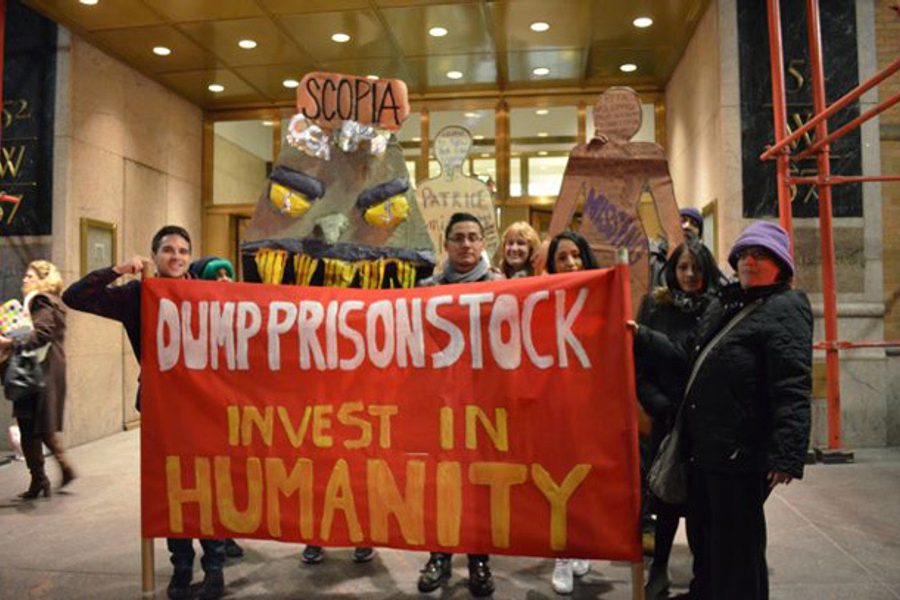Banking on Detention: Demonstrators Call on Wells Fargo to Divest from Private Prisons
Rebecca Burns

After Ancelma’s husband was deported to Mexico, she found herself unable to close a bank account with Wells Fargo that was accruing overdraft fees. Though it has marketed itself as a bank of choice for the Latino community — accepting matricula cards that give undocumented immigrants access to banking services and even establishing “Wells Fargo Amigos” outreach teams — the bank refused to accept her husband’s authorization to close the account because it was written in Spanish.
The family soon learned this wasn’t the only way in which Wells Fargo is less “immigrant-friendly” than it first appears: The financial institution also invests heavily in the private prison industry that lobbies for and profits from harsher immigration enforcement and detention.
Ancelma’s story is one of several detailed in a series of reports urging Wells Fargo to break ties with private prison operators. In September, National People’s Action and the National Prison Divestment Campaign exposed that the bank was heavily invested in two major such companies with nearly $100 million of holdings in GEO Group and nearly $3 million in the Corrections Corporation of America (CCA). The groups launched a public pressure campaign, branding the bank “Jails Fargo” and holding demonstrations outside its branches.
In late October, they declared victory when Wells Fargo’s most recent SEC filings revealed that it had divested more than a third of its holdings in GEO Group.
Help keep this reporting possible by making a donation today.
Prison divestment organizers are encouraged by this move, but say it doesn’t yet go far enough. During a national day of action yesterday, activists in nine cities staged demonstrations to call for full divestment from the private prison industry. “Wells Fargo still provides a $700 million line of credit without which CCA could not build new prisons,” explains Peter Cervantes-Gautschi, executive director of Enlace, a national alliance of low-wage worker centers that coordinates the National Prison Divestment Campaign. “And beyond this, we’re asking all institutions, public and private, to cut ties with this industry — much as people of conscience divested from apartheid South Africa in the 1980s.”
The National Prison Divestment Campaign, launched in spring 2011, brings together labor and faith organizations with immigrant rights groups alarmed by the explosion of private detention centers. In 2005, private prison operators gained a major foothold in the field of immigrant detention with the start of Operation Streamline, a policy mandating criminal, as opposed to civil, prosecution of undocumented immigrants crossing the border. As the result of this shift, and the redefinition of acts like “illegal border crossing” as immigration felonies, Latinos now constitute the majority of those sentenced for federal crimes. Nearly half of immigrants convicted of such crimes are held in private facilities.
The private prison industry has been involved in lobbying heavily for both new immigrant detention centers and tougher enforcement policies that will help fill them. In 2010, In These Times reporter Beau Hodai uncovered CCA’s pivotal role in shaping SB 1070, Arizona’s anti-immigrant law. Thirty out of the 36 state legislators who co-sponsored the bill received campaign contributions from private prison companies. Though the Supreme Court struck down three out of the bill’s four provisions earlier this year, the “show me your papers” law that invites racial profiling by law enforcement remained intact, and has since taken effect in Arizona.
SB 1070 is far from the only instance where private prison companies have prevailed in securing such lucrative arrangements. During the past decade, the AP reported in August, the three major private prison companies have spent $45 million in lobbying and campaign contributions. This was money well-spent: Whereas ten years ago, private prison operators held two federal contracts worth about $760 million, the Federal Bureau of Prisons today pays these companies $5.1 billion through 13 different contracts.
The result is more than 23,000 immigrants detained for federal crimes, up from just over 3,000 a decade ago. Cervantes-Gautschi asserts that this drastic increase is clearly the result of profit-motivated policy shifts: “More than half of immigrants in the federal prison system are being held for things not even considered crimes six years ago,” he says.
Demonstrations held across the country yesterday targeted Wells Fargo, GEO headquarters, and the hedge fund Scopia, which according to Enlace is the largest investor in GEO Group among hedge funds. As New York demonstrators assembled outside Scopia’s offices, protesters carried life-sized black silhouettes labeled “missing” to symbolize the destruction of communities wrought by rising levels of detention.
“Each silhouette represents a missing member of our community,” explains Andalusia Soloff of the group Families for Freedom. “A person who, no matter the legal status, residency, or citizenship of the person has been removed and sent away, leaving their families and loved ones behind.”
Rebecca Burns is In These Times’ housing editor and an award-winning investigative reporter. Her work has appeared in Business Insider, the Chicago Reader, the Intercept, ProPublica Illinois and other outlets.




